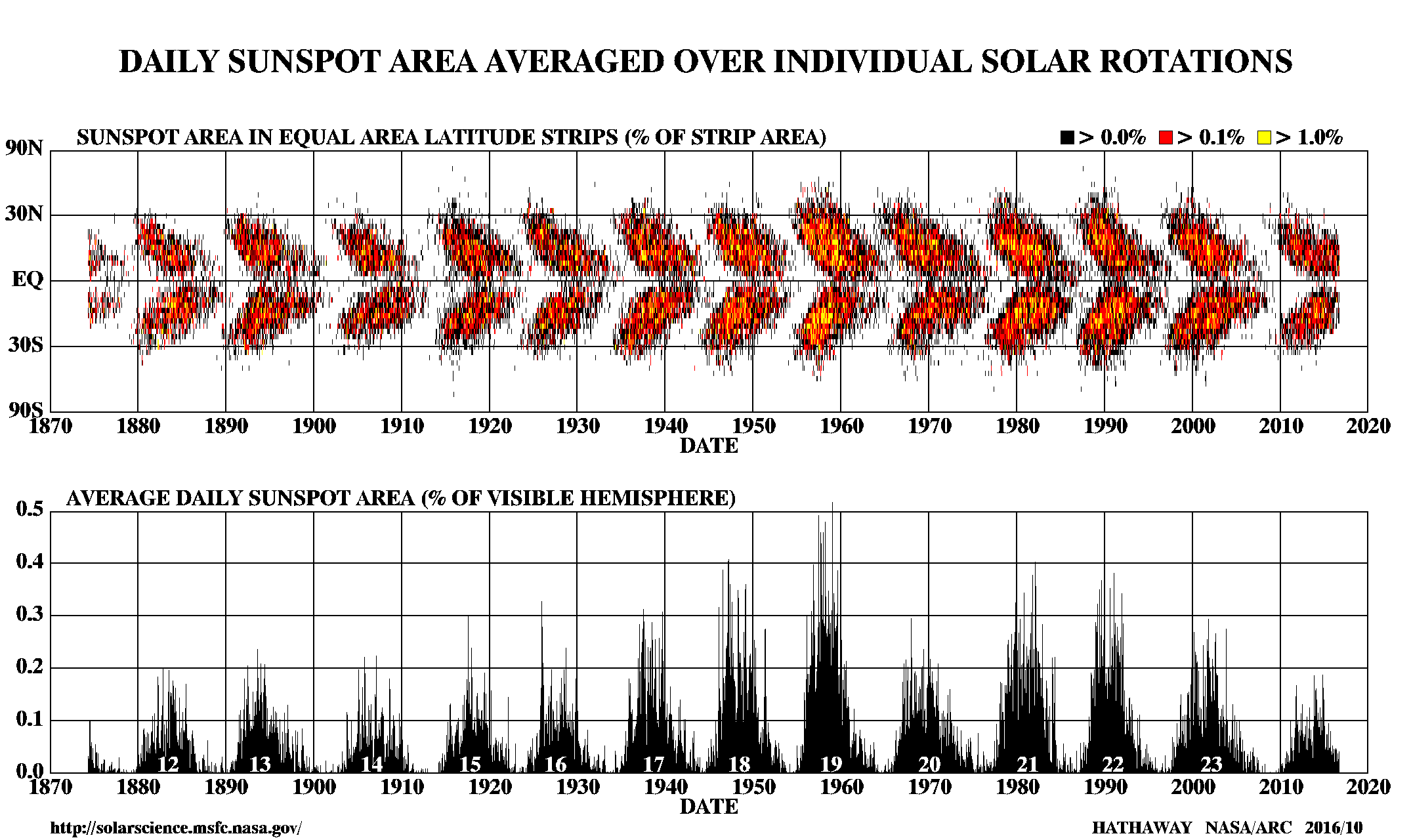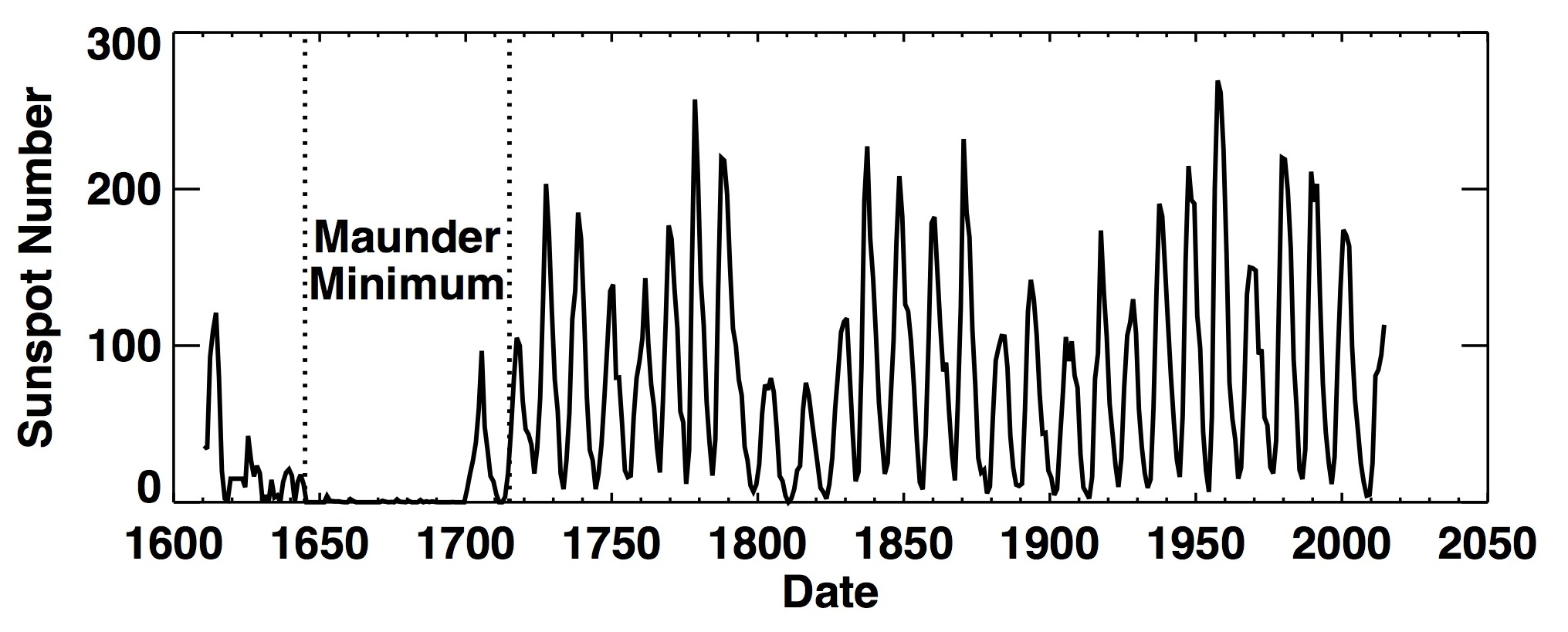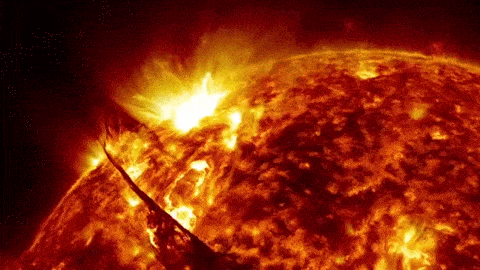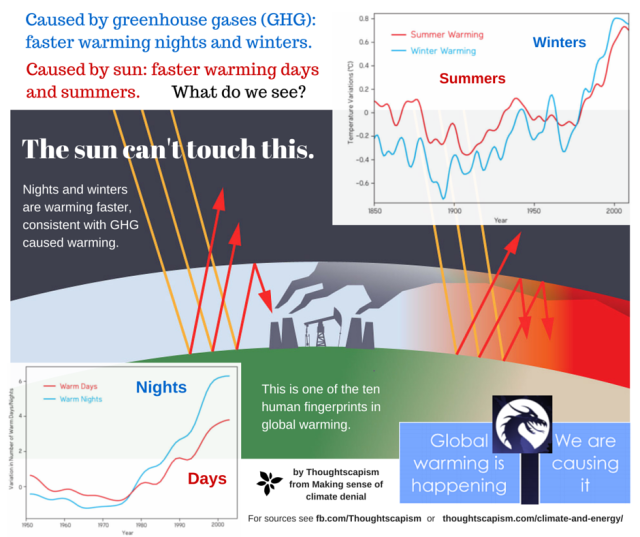The Solar Cycle
The Sun goes through an approximately 11 year periodic solar cycle (Gnevyshev 1967). This cycle includes variations in solar irradiation, the amount of ejected materials, solar flares and sunspot activity. Total Solar Irradiance (TSI) is measured in power per unit area (energy per unit time per unit area), and is of particular importance in that it represents the total incoming energy driving the climate system.
Since we’ve only had direct satellite measurements of TSI since the mid-late 1970s, estimates of solar output for earlier times were (and are) based on one or more proxies. Sunspot observations are one such proxy. Sunspot abundance correlates strongly with TSI, so they can thus be used as a proxy for solar maxima and minima. Astronomers have recorded telescopic sunspot observations since the early 1600s, and there is evidence of naked eye observations dating much further back (Stephenson 1990). In addition to noticing that the number of sunspots oscillated in 11 year cycles, astronomers also noticed that sunspots would first appear in pairs or groups at about 30 – 35 degrees both North and South of the solar equator, and the mean latitudes of subsequently appearing spots would tend to migrate towards the solar equator as the cycle progressed, a phenomenon referred to as Spörer’s Law (Carrington 1858, Carrington 1863, Spörer 1879).
Closely related to this is Joy’s Law, which is the observation that the spots tend to be “tilted,” in the sense that the leading spots tend to be closer to the solar equator than the following spots, and that the magnitude of the slope of that tilt increases with latitude (Hale et al 1919, Wang 1989, d’Silva 1992, Tian 2001). These sunspots emerge in regions of bipolar magnetic field lines, whereby the typical pair of North-South sunspot counterparts are of opposite polarity of one another (Hale 1915). When the observed patterns of emergence of these sunspots are plotted over time, they give rise to what are referred to as butterfly diagrams.

Sunspot Butterfly Diagrams c/o NASA
In the early 20th century, G.E. Hale observed the Zeeman splitting of spectral lines from sunlight, which suggested the existence of magnetic field lines at the solar surface (Hale 1908). Subsequently, Hale and other astronomers deduced that sunspots were regions of particularly strong magnetic fields, and that their dark appearance was due to them being cooler than their surroundings (about 3,700 K, as opposed to about 5,700 K for their surroundings). They also figured out that, when polarity is taken into account, the 11 year sunspot cycle was really part of a 2*11 = 22 year cycle, whereby the polarity of the magnetic fields of the sunspots in the second half of the 22 year cycle was the reverse of their polarity in the first half (Hale 1924). This is called Hale’s Polarity Law. Since periods of maximum and minimum sunspot activity correspond to solar maxima and minima, they make for excellent proxies for variables such as Total Solar Irradiance.
Through the use of dendroclimatological (tree ring) and other proxy data, scientists have put together sunspot and solar activity reconstructions stretching back over 11,000 years (Solanki 2004, Beer 2000, Usoskin 2006). This is possible because the flux of high energy cosmic rays entering earth’s atmosphere is modulated by solar magnetic activity (particularly the solar wind)(Stuiver 1980, Beer 2000). These particles are responsible for the production of certain radio isotopes, such as 14C and 10Be, whose respective abundances are anti-correlated with solar magnetic activity. The former is preserved in tree rings, while the latter is preserved in ice caps (Beer 2000, Bard 1997, Stuiver 1980). Here are some data sets for your perusal.
Grand Solar Maxima and Minima
It’s important to note that not all solar cycles are equal. Solar maxima and minima can vary in amplitude from one solar cycle to the next, and in some cases extended Grand Solar Maxima and Minima can arise (Gleissberg 1939). Additionally, stronger cycles tend to rise more quickly and peak earlier than weaker cycles: a phenomenon known as the Waldmeier effect (Waldmeier 1941, Karak and Choudhuri 2011), though not all measures of solar activity exhibit this effect (Dikpati et al 2008, Cameron and Schussler 2008). The occurrences of grand solar maxima and minima are driven in part by stochastic and/or chaotic processes that result from the complicated action of the solar dynamo: the physical mechanism underlying solar cycles (Charbonneau 2000), which I will attempt to elucidate soon enough.
The Maunder Minimum
The Maunder Minimum, which took place in middle of a roughly 550 year period known as the Little Ice Age, was an example of a Grand Solar Minimum (Eddy 1976). More specifically, the Maunder Minimum refers to an extended period of very low sunspot activity spanning from about 1645 – 1715. As a point of reference, this period coincided almost exactly with the reign of the French monarch, Louis XIV (known to his subjects as “The Sun King”), whom you may remember reading about in history class. He had the longest reign of any king in all of European history (1643 – 1715), and is often presented as the quintessential example of a European Absolute Monarch. In science, this period also saw the publication of Newton’s Principia, Robert Hooke’s discovery of the cell as the fundamental biological unit, Newton and Leibniz’s co-discovery of calculus, and the discovery of Boyle’s law for ideal gases. During this period, very few sunspots were observed. One might assume that this was due to a lapse in vigilance on the part of European astronomers, but that was not the case. There really was significantly less sunspot activity than usual during the Maunder Minimum (Ribes et al 1993), hence why it is often given as a recent example of a Grand Solar Minimum. Perhaps unsurprisingly, the Earth was slightly cooler during this time (Guinan 2002).

Average Sunspot numbers during the Maunder Minimum (c/o NASA)
So, what causes grand solar minima and maxima? For that matter, what causes the maxima and minima of the usual 11 year solar cycle? Why do these cycles exist? In order to unpack the concepts underlying the mechanism by which changes in the sun’s magnetic field produce these solar cycles (called the solar dynamo), it is necessary to give a brief overview of the structure of the sun, and the characteristics of its different layers. I’ll cover that in part II.
Related Articles:
- How Continental Drift affects Climate: Part I – Plate Tectonics, Albedo, and the SnowBall Earth Hypothesis
- How Continental Drift affects Climate: Part II – Possible Snowball Earth Triggering Mechanisms + Regional Effects of Mountain Ranges
- Milankovitch Cycles and Climate: Part I – Axial Tilt and Precession
- Milankovitch Cycles and Climate: Part II – Orbital Eccentricity, Apsidal Precession and Orbital Inclination
- Milankovitch Cycles and Climate: Part III – Putting it All Together
- The Climatological effects of Volcanic Eruptions: The End Permian Extinction, the Toba Super-Volcano, and the Volcanic Explosivity Index
- The Ultimate Environmental Cataclysm: Asteroid and Comet Impacts and their Effects on Climate
References:
Bard, E., Raisbeck, G. M., Yiou, F., & Jouzel, J. (1997). Solar modulation of cosmogenic nuclide production over the last millennium: comparison between 14C and 10Be records. Earth and Planetary Science Letters, 3(150), 453-462.
Beer, J. (2000). Long-term indirect indices of solar variability. Space Science Reviews, 94(1-2), 53-66.
Cameron, R., & Schüssler, M. (2008). A robust correlation between growth rate and amplitude of solar cycles: consequences for prediction methods. The Astrophysical Journal, 685(2), 1291.
Carrington, R. C. (1858). On the distribution of the solar spots in latitudes since the beginning of the year 1854, with a map. Monthly Notices of the Royal Astronomical Society, 19, 1-3.
Carrington, R. C. (1863). Observations of the spots on the sun: from November 9, 1853, to March 24, 1861, made at Redhill. Williams and Norgate.
Charbonneau, P., & Dikpati, M. (2000). Stochastic fluctuations in a Babcock-Leighton model of the solar cycle. The Astrophysical Journal, 543(2), 1027.
Dikpati, M., Gilman, P. A., & De Toma, G. (2008). The waldmeier effect: an artifact of the definition of wolf sunspot number?. The Astrophysical Journal Letters, 673(1), L99.
D’Silva, S. (1992). Joy’s Law and Limits on the Magnetic Field Strength at the Bottom of the Convection Zone. In The Solar Cycle (Vol. 27, p. 168).
Eddy, J. A. (1976). The Maunder Minimum. Science, 192, 1189-1202.
Gleissberg, W. (1939). A long-periodic fluctuation of the sun-spot numbers. The Observatory, 62, 158-159.
Gnevyshev, M. N. (1967). On the 11-years cycle of solar activity. Solar Physics, 1(1), 107-120.
Guinan, E. F., & Ribas, I. (2002). Our changing Sun: the role of solar nuclear evolution and magnetic activity on Earth’s atmosphere and climate. In The evolving Sun and its influence on planetary environments (Vol. 269, p. 85).
Hale, G. E. (1908). On the probable existence of a magnetic field in sun-spots. The astrophysical journal, 28, 315.
Hale, G. E. (1915). The Direction of Rotation of Sun-Spot Vortices. Proceedings of the National Academy of Sciences, 1(6), 382-384.
Hale, G. E., Ellerman, F., Nicholson, S. B., & Joy, A. H. (1919). The magnetic polarity of sun-spots. The Astrophysical Journal, 49, 153.
Hale, G. E. (1924). Sun-spots as magnets and the periodic reversal of their polarity. Nature, 113, 105-112.
Karak, B. B., & Choudhuri, A. R. (2011). The Waldmeier effect and the flux transport solar dynamo. Monthly Notices of the Royal Astronomical Society, 410(3), 1503-1512.
Ribes, J. C., & Nesme-Ribes, E. (1993). The solar sunspot cycle in the Maunder minimum AD1645 to AD1715. Astronomy and Astrophysics, 276, 549.
Solanki, S. K., Usoskin, I. G., Kromer, B., Schüssler, M., & Beer, J. (2004). Unusual activity of the Sun during recent decades compared to the previous 11,000 years. Nature, 431(7012), 1084-1087.
Spörer, F. W. (1879). Beobachtung der Sonnenflecken etc. Astronomische Nachrichten, 96, 23.
Stephenson, F. R. (1990). Historical evidence concerning the sun: interpretation of sunspot records during the telescopic and pretelescopic eras. Philosophical Transactions of the Royal Society of London A: Mathematical, Physical and Engineering Sciences, 330(1615), 499-512.
Stuiver, M., & Quay, P. D. (1980). Changes in atmospheric carbon-14 attributed to a variable sun. Science, 207(4426), 11-19.
Tian, L., Bao, S., Zhang, H., & Wang, H. (2001). Relationship in sign between tilt and twist in active region magnetic fields. Astronomy & Astrophysics, 374(1), 294-300.
Usoskin, I. G., Solanki, S. K., & Korte, M. (2006). Solar activity reconstructed over the last 7000 years: The influence of geomagnetic field changes. Geophysical Research Letters, 33.
Waldmeier, M. (1941). Ergebnisse und probleme der sonnenforschung, von dr. M. Waldmeier… MIT 102 figuren. Leipzig, Becker & Erler kom.-ges., 1941., 1.
Wang, Y. M., & Sheeley Jr, N. R. (1989). Average properties of bipolar magnetic regions during sunspot cycle 21. Solar physics, 124(1), 81-100.




5 Comments
The Structure and Properties of the Sun – The Credible Hulk · January 11, 2017 at 1:18 pm
[…] my most recent post, I discussed the characteristics of the sun’s 11 and 22 year cycles, the observed laws which […]
The Solar Dynamo: The Physical Basis of the Solar Cycle and the Sun’s Magnetic Field – The Credible Hulk · January 14, 2017 at 1:52 am
[…] I could then explain the physical mechanism which underlies the solar cycles I talked about in the article prior to that one. I understand that this is a bit more technical than most readers may be accustomed to, which is […]
Mean Field Theory and Solar Dynamo Modeling – The Credible Hulk · January 16, 2017 at 12:38 pm
[…] a recent post, I talked about the characteristics of the sun’s 11 and 22 year cycles, the observed laws which […]
No, Solar Variations Can’t Account for the Current Global Warming Trend. Here’s Why: – The Credible Hulk · January 17, 2017 at 5:07 pm
[…] part I of this series on the sun and Earth’s climate, I covered the characteristics of the sun’s 11 […]
The One True Argument^TM – The Credible Hulk · April 30, 2017 at 2:26 am
[…] impacts can affect the climate with hundreds of citations from credible scientific journals here, here, here, here, here, here, here, here, here, here, here, and […]
Comments are closed.